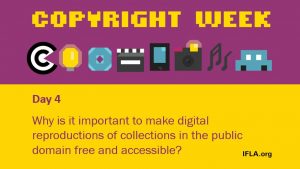
What is the public domain?
The public domain includes all creative works to which no exclusive intellectual property rights apply.
Works protected by copyright are those where the rightsholder has the potential to limit access and many uses in exchange for remuneration.
After the death of the author of the work, the work continues to be protected by copyright to the benefit of whoever holds the rights subsequently for an X time (depending on the copyright of the country).
At the end of this period of copyright protection, the work falls into the public domain. The work is, therefore, no longer the subject of remuneration or a monopoly.
Each country has different legislation on the term of copyright protection.
Why is it important to keep the public domain free and accessible?
_ The public domain must be free and accessible because it must be accessible to everyone. Social and economic inequalities are accelerating, and free access to culture lowers these barriers.
_ The public domain must be free and accessible because all nations need access to their history and heritage.
_ The public domain must be free and accessible because social, historical, literary progress is built brick after brick to build together have common bases, a common history.
Why digitised works in the public domain should be labelled with the public domain mark instead of a copyright mark?
It is a strategic decision for the establishment, which requires collaboration from several sectors: the digital department, the collections department and the department linked to the public.
Until now, there has been a legal vagueness regarding the fact of putting a copyright mark on a reproduction of an object in the public domain.
However, many institutions are committed to the principles of OpenGLAM, for example, one of the principles of which is not to add copyright to heritage collections.
Copyright is defined by the creativity of its author, and it is precisely the creativity of the author that is rewarded by copyright.
_ This limits the dissemination of collections since the photos cannot be shared freely.
_ This limits the use and re-use of reproductions of public domain collections for the general public, but also research and education.
_ This risks representing an inaccurate declaration of copyright.
How to combine business models and accessible public domain?
The mass digitisation of artefacts may involve high costs (material, human resources, skills), and so many institutions are invited by their supervision to find economic models involving digitised content in order to contribute to the establishment’s revenues.
If the ideal would be to have a strong (and financed) policy of national digitisation to make works in the public domain (or reproductions of them) free to access and use, in practice, the heritage institutions face these permanent demands to cover costs.
Nonetheless, some institutions have developed different user-pays business models to digitise collections which do not exclude free public access, for example:
_ offering on-demand digitisation services for a fee for the first user, but then making the digital work available free of charge under a label in the public domain or CC0)
_ carrying out public-private digitization partnerships. While this type of partnership often raises questions about the respect of the public domain, given exclusivity rights over reproductions for a commercial purpose, it can become more interesting if this period of exclusivity is only for a reasonable time.
At the same time, numerous reports have assessed the general costs, i.e. the investments of the institutions in digitisation and the revenues made by making access pay.
On the one hand, the revenue from paid access to collections is often a drop in the ocean of digitisation costs. On the other hand, this drop of water can make a difference in terms of accessibility at the user level and will limit access and use of the collections for the broader public, research and educational purposes.
What does the European DSM Directive Say?
In the Copyright Directive currently being implemented in Europe, Article 14 addresses this issue. It especially deals with works of visual art in the public domain.
This provision proposes in particular to introduce the following rule:
“Works in visual art in the public domain: Member States shall provide that, when the term of protection of a work of visual art has expired, any material resulting from an act of reproduction of that work is not subject to copyright or related rights, unless the materiel resulting from that act of reproduction is original in the sense that it is the author’s own intellectual creation.”
In other words, the reproduction of visual works in the public domain (i.e. when the copyright expires) should not benefit from new protection of copyright or related rights unless the reproduction is modified and presented new creative forms of the author.
In practice, this essentially aims to allow faithful reproductions of works in the public domain to remain in the public domain and thus facilitate access to culture. We look forward to seeing the results!